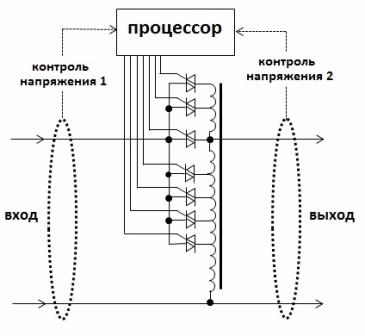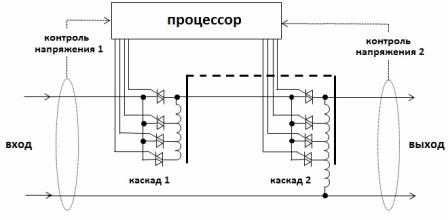The principle of operation of an electronic voltage regulator
 Voltage stabilizers are becoming increasingly popular, both among homeowners and designers during the construction phase. Today, in stabilizers, an autotransformer is most often used. The principle of the autotransformer is known and has long been used for voltage conversion and stabilization.
Voltage stabilizers are becoming increasingly popular, both among homeowners and designers during the construction phase. Today, in stabilizers, an autotransformer is most often used. The principle of the autotransformer is known and has long been used for voltage conversion and stabilization.
However, the autotransformer control method itself has undergone many changes. While before the voltage regulation was done manually or in extreme cases it was controlled by an analog board, today the voltage stabilizer is controlled by a powerful processor.
Innovative technologies have not bypassed the way the coils are switched. Previously, relay switches or mechanical current collectors were used, today triacs play their role. Replacing the mechanical elements with triacs made the stabilizer silent, durable and maintenance-free.
The modern voltage stabilizer works on the principle of electronic switches switching the windings of the autotransformer under the control of a processor with a special program.
The main function of the processor is to measure the input and output voltage, analyze the situation and turn on the corresponding triac.
However, these are far from all the functions of the processor. In addition to voltage regulation, the processor performs a number of functions related to the operation of the stabilizer.

The most important thing is the release of triacs.
To eliminate the distortion of the sine wave, the triac must be turned on exactly at the zero point of the voltage sine wave. To do this, the processor makes several tens of voltage measurements and at the right moment sends a powerful pulse to the triac, provoking it to turn on (unlock).
But before doing this, it is necessary to check whether the previous triac is turned off, otherwise there will be a counter current (triacs are quite difficult elements to control and cases of turning off can occur for many reasons, for example with interference).
By measuring the microcurrents, the processor analyzes the state of the electronic switches and only then performs the actions.

You should understand that the processor does all this in less than 1 microsecond, having time to perform calculations while the voltage sine wave is in the region of the zero point. The operations are repeated at each half-phase.
The high speed of both the processor and the triac switches made it possible to create an instantly responsive voltage regulator. Today, the process of electronic stabilizers rises for 10 milliseconds, that is, for one voltage half-phase. This allows you to reliably protect the equipment from power anomalies.
In addition, the speed of the processor made it possible to create more accurate stabilizers using a two-stage control system. Two-stage regulators process the voltage in two stages. For example, the first stage can only have 4 stages. After roughing, the second stage is turned on and the voltage is brought to ideal.
Using a two-stage control chain allows you to reduce the cost of products.
Judge for yourself, if there are only 8 triacs (4 on the first stage and 4 on the second), the adjustment steps already become 16 — by the combined method (4×4 = 16).
Now, if it is required to produce a high-precision stabilizer, say, steps of 36 or 64, much fewer triacs will be needed — 12 or 16, respectively:
for 36-stage, the first stage is 6 triacs, the second stage is 6 triacs 6×6 = 36;
for 64 stages, the first stage is 8 triacs, the second stage is 8 triacs 8×8 = 64.
It is noteworthy that both stages use the same transformer. In fact, why put the second, if everything can be done on one.
The speed of such a stabilizer can be slightly reduced (reaction time 20 milliseconds). But for household appliances, this order of numbers still doesn't matter. The fix is almost instant.
In addition to switching triacs, additional tasks are assigned to the processor: monitoring the state of modules, monitoring and displaying processes, testing circuits.
